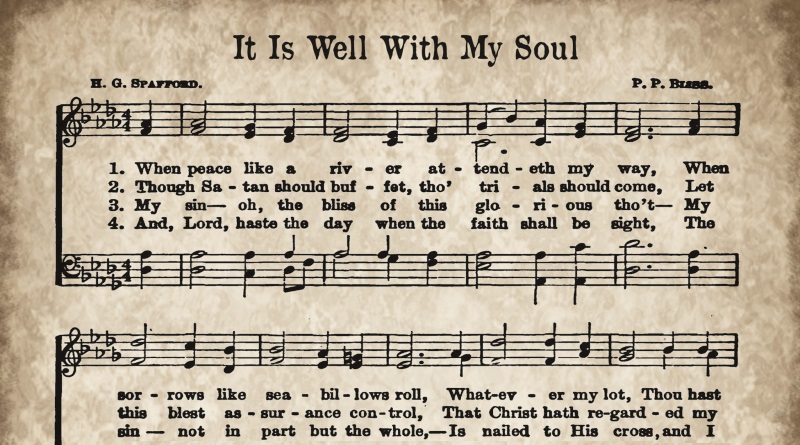It Is Well with My Soul: the rest of the stories
You’ve probably heard the famous story of Haratio Spafford writing “It Is Well with My Soul” following the death of his four daughters. The story goes that as he sailed across the area where their ship went down and they drowned, he wrote the popular hymn.
When peace, like a river, attendeth my way,
When sorrows like sea billows roll;
Whatever my lot, Thou has taught me to say,
It is well, it is well, with my soul.
[chorus]
It is well, with my soul,
It is well, with my soul,
It is well, it is well, with my soul.
Though Satan should buffet, though trials should come,
Let this blest assurance control,
That Christ has regarded my helpless estate,
And hath shed His own blood for my soul.
[chorus]
My sin, oh, the bliss of this glorious thought!
My sin, not in part but the whole,
Is nailed to the cross, and I bear it no more,
Praise the Lord, praise the Lord, O my soul!
[chorus]
And Lord, haste the day when my faith shall be sight,
The clouds be rolled back as a scroll;
The trump shall resound, and the Lord shall descend,
Even so, it is well with my soul.
[chorus]
Some of the story may be true, but there’s much more to the story before and after the song!
In the 1870s, Spafford was a very successful lawyer in Chicago and heavily invested in real estate. In 1871, the great Chicago fire destroyed all his downtown investment properties.
In 1873, he and his family planned a vacation trip to Europe. While in Great Britain, he planned to help his good friend Dwight L. Moody and Ira Sankey, whom he had financially supported, with their evangelistic tour. Spafford sent his wife and four girls—ages 11, 9, 7 and 2—ahead while he finished up last-minute business in Chicago. On November 22, the S.S. Ville Du Havre struck another ship and sank within twelve minutes. Mrs. Spafford cabled her husband “Saved alone.”
One story reports that Spafford wrote “It Is Well with My Soul” while passing over the very spot of the ocean where his four daughters perished while another, more reliable report, claims he wrote it two years later when Moody and Sankey were visiting his home.
But the tragedy surrounding the hymn didn’t end there. Horatio and Anna returned to Chicago and gave birth to Horatio Goertner Spafford who would die at three years old of scarlet fever. Two years later, the couple gave birth to Bertha, who would write that her parents not only suffered the pain of losing their fortune and five children, but it was compounded by a crisis of faith. Were the children’s deaths a punishment from God? Did He no longer love them? Horatio felt himself in danger of losing his faith.
In 1881, Anna gave birth to a sixth daughter, appropriately named “Grace.” Shortly after, the family of four moved to Jerusalem, with Horatio explaining, “Jerusalem is where my Lord lived, suffered, and conquered, and I wish to learn how to live, suffer, and especially to conquer.”
The family would remain in Jerusalem and set up a children’s home. And like his children, he too would die tragically. Some reports claim he began to suffer delusions that he was the second Messiah, while his family insists it was the malaria fever from which he died that caused the mental confusion.
But the tragedy surrounding the hymn didn’t end there, either. The tune was written by Philip P. Bliss, which he entitled “Ville du Havre,” the name of the ship that took the lives of Spafford’s four daughters. The hymn was first sung by Bliss himself before a large gathering of ministers hosted by Moody on November 24, 1876.
Just one month later, on December 29, 1876, Bliss and wife were traveling to Chicago by train. As the train passed over a trestle near Ashtabula, Ohio, the bridge collapsed and the passenger coaches plunged 75 feet into the icy river. Philip was able to escape through a window, but his wife was pinned in the wreckage. As he went back to free his wife, a fire broke out through the wooden cars and both were burned beyond recognition.
Nine tragic deaths surround the hymn, and yet those affected by them, could say, “It is well with my soul.” And to me, that is indeed “blest assurance.” It is well with my soul . . . if nothing else!
© Copyright 2008 James N. Watkins. All rights reserved.


Hey James! Love your site! I am a blogger too! I’ve written youth lessons for years, and am finally getting them published more online. I read this article a couple years ago when teaching teens about having joy in all circumstances, and passed out copies of this article for them to take home. Fascinating story!
I gave you a shout out here in my latest article:
http://anchor2hope.com/3-ways-to-be-positive-this-year/
Thanks so much, Nicole! And visitors, please check out Nicole’s blog!